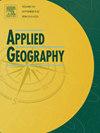Environmental determinants of dynamic jogging patterns: Insights from trajectory big data analysis and interpretable machine learning
IF 4
2区 地球科学
Q1 GEOGRAPHY
引用次数: 0
Abstract
The dynamic patterns of leisure jogging profile the jogger-environment interactions. However, the dynamic patterns and their nonlinear associations with environmental factors are poorly explored. Therefore, we develop a framework to uncover the dynamic jogging patterns and interpret their nonlinear and interactive associations with environments. Initially, the bivariate time series clustering method discerns daily and weekly patterns from the integrated jogging flow and duration. Then, interpretable machine learning methods including CatBoost, SHAP, and ALE plots elucidate the nonlinear and interactive relationships. An empirical analysis of Beijing, China was conducted using multisource data. Our finding highlights that (1) five distinct daily and weekly jogging patterns were investigated for area zoning. These patterns show notable spatial-temporal disparities in jogging flow and duration. (2) Built environment (BE) and visual environment are crucial in shaping jogging, with accessibility and facilities being significant contributors. (3) Environmental variables show significant nonlinear and threshold effects on leisure jogging, which vary across jogging patterns and urban areas. (4) Interaction effects among environmental factors were investigated. BE factors like sports amenity exert more significant interactions. Importantly, incorporating geographic locations enhances model performance as it captures spatial effects. These findings can help planners design refined intervention strategies for leisure activities.
动态慢跑模式的环境决定因素:来自轨迹大数据分析和可解释机器学习的见解
休闲慢跑的动态模式描述了慢跑者与环境的相互作用。然而,对其动态模式及其与环境因子的非线性关系的研究却很少。因此,我们开发了一个框架来揭示动态慢跑模式,并解释它们与环境的非线性和交互关联。最初,二元时间序列聚类方法从综合慢跑流量和持续时间中识别每日和每周模式。然后,包括CatBoost、SHAP和ALE图在内的可解释机器学习方法阐明了非线性和交互关系。使用多源数据对中国北京进行了实证分析。研究结果表明:(1)研究了五种不同的日慢跑和周慢跑模式。这些模式在慢跑流量和持续时间上存在显著的时空差异。(2)建筑环境和视觉环境是慢跑形成的关键因素,可达性和设施是慢跑形成的重要因素。(3)环境变量对休闲慢跑的影响表现出显著的非线性和阈值效应,在不同的慢跑模式和不同的城市中存在差异。(4)考察了环境因子间的交互效应。运动舒适性等BE因素的交互作用更为显著。重要的是,结合地理位置可以提高模型的性能,因为它捕获了空间效应。这些发现可以帮助规划者设计出精细的休闲活动干预策略。
本文章由计算机程序翻译,如有差异,请以英文原文为准。
求助全文
约1分钟内获得全文
求助全文
来源期刊

Applied Geography
GEOGRAPHY-
CiteScore
8.00
自引率
2.00%
发文量
134
期刊介绍:
Applied Geography is a journal devoted to the publication of research which utilizes geographic approaches (human, physical, nature-society and GIScience) to resolve human problems that have a spatial dimension. These problems may be related to the assessment, management and allocation of the world physical and/or human resources. The underlying rationale of the journal is that only through a clear understanding of the relevant societal, physical, and coupled natural-humans systems can we resolve such problems. Papers are invited on any theme involving the application of geographical theory and methodology in the resolution of human problems.
 求助内容:
求助内容: 应助结果提醒方式:
应助结果提醒方式:


